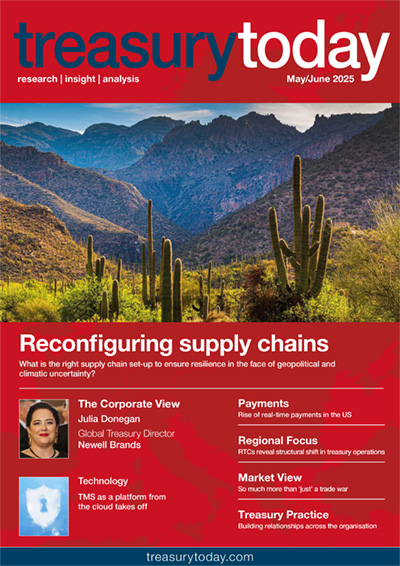Contents
- Editorial
- Calm in the storm
- Insight & Analysis
- Reconfiguring supply chains
- Treasury Practice
- Secrets of a successful partnership
- The Corporate View
- Julia Donegan, Newell Brands
- Regional Focus
- RTCs in MENA: a growing trend
- Technology
- Why treasurers are opting for cloud based TMS
- Payments
- A tale of two payment systems
- Question Answered
- How to set up an in-house bank
- Market View
- So much more than ‘just’ a trade war
Editorial
Calm in the storm
US President Donald Trump’s rollout of sweeping tariffs on imports and retaliatory measures from trading partners around the world has upended financial markets and triggered fears of inflation and recession. The corporate world is reeling, profit outlooks have been rewritten and many fear global growth will fall as the President and his team overhaul US economic policy and reverse decades of globalisation.
As companies scramble to secure their supply of crucial inputs, materials and manufactured products, this edition explores what constitutes the optimum supply chain set-up to ensure stability in the face of geopolitical uncertainty and how supply chain finance can help build resilience.
Our interviewees report a notable shift towards nearshoring, especially in regions like North America, Europe and Asia Pacific and we find corporate treasurers working with banks to leverage numerous working capital techniques such as receivables, payables and inventory financing to enable business, derisk supply chains, improve financial indicators and build more sustainable value chains.
During times of uncertainty and volatility, the importance of smooth technological processes and real-time visibility also comes to the fore. We report how treasury is benefitting from scalability, and the ability to respond to increased demand, accessibility and cost efficiency by hosting TMS as a platform in the cloud. Cloud solutions also go hand-in-hand with demand for compute coming from AI but involve treasury grasping an OPEX model of using technology.
This edition’s Corporate View features Julia Donegan, Global Treasurer at Newell Brands. In a timely reflection, she considers the role of treasury when economic conditions grow challenging and advises on the importance of a clear view of the end goal and the value of drawing on the lessons from the past.
Elsewhere we explore innovation in real-time payments in the US, a market that has lagged other regions but where the arrival of two separate instant payment systems, RTP and FedNow, has stepped up the pace of change.
Our Question Answered delves into the do’s and don’ts when setting up an in-house bank and we also explore the key themes driving corporates to establish regional treasury centres in MENA. In a trend that is being fanned by geopolitics, we find many MNCs seek to differentiate between restricted and free-market treasury operations by creating a new base in the Middle East. The benefits span real-time oversight, faster decision-making and regional insights on capital controls, repatriation constrains and compliance requirements, more valuable than ever in a changing world.


